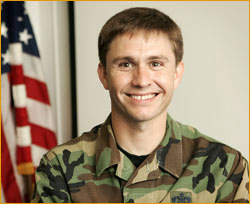2006 Airman of the Year
winner

Tech Sergeant Shane Hobrecht
Born on the Colville Indian Reservation in Omak, Wash. Played forward for the Oklahoma City Stampede, a semipro soccer team, from 1991 to 1993. Hobbies include cooking and trout fishing.
WURZBURG ARMY INSTALLATION, Germany - When U.S. troops foil a plot to harm the homeland or interests abroad, details about their heroics often stay mostly under wraps. That's the nature of special operations.
Consequently, the highlight reels don't usually contain stories that showcase the exploits of airmen like Tech. Sgt. Shane Hobrecht. But when such stories are told, they illuminate the lengths to which special operations forces go in their effort to thwart terrorists, and the moral character necessary to carry out the fight with nothing less than total confidence.
As a joint terminal attack controller, or JTAC, Hobrecht serves as the conduit between an Army commander on the ground and, for example, an F-16 pilot waiting aloft for the order to zero in on a target and destroy it.
Members of his command, noting the clear risks associated with calling in an airstrike on a location while sometimes standing not too far away, have said no one in the Air Force does it better than he.
These special forces teams aren't "playing a video game," said Lt. Col. Lee Marsh, commander of Hobrecht's unit, the 2nd Air Support Operations Squadron, with headquarters at the Army post in Wurzburg, Germany.
"They know when to go subtle, they know when to go hard, they know when to back off," Marsh said. "This job requires highly adaptive, highly motivated and highly intelligent individuals, and he fits into that [special ops] world perfectly."
Case in point: Late last year, Hobrecht was among the elite U.S. troops who undertook two simultaneous raids and nabbed a cadre of would-be suicide bombers en route to the U.S. from a camp in the Middle East.
Hobrecht was the primary JTAC for one raid, so he was in on the planning and execution of reconnaissance before and during the incident, as well as the air cover provided after it went down.
Saying it was all in a day's work seems like a trite summary of the intricate set of actions that may have saved an untold number of lives. But even Hobrecht struggles to put it succinctly.
"It's hard to differentiate the missions," he said. "They don't really come with a priority. It's kind of a repetitive thing. When you do get something bigger than everything else, it doesn't seem that different until you've done it."
Hobrecht's handiwork during a 2005 deployment to Iraq resulted in the death or capture of more than 130 enemy fighters, including a purported bomb-maker, following close-air support missions. In one instance, he physically ran down a guy trying to elude capture by ducking into a patch of tall grass growing in the Tigris River.
He's earned two Bronze Stars for his combat actions, but the praise heaped upon Hobrecht by his command stems also from his accomplishments off the battlefield.
For example, they laud him for designing the squadron's new operations center, which they say has revolutionized how JTACs throughout Europe train to control close-air support missions using forward observers hundreds of miles away.
Regarded as a role model to those learning the craft, Hobrecht, also a JTAC instructor and evaluator, was 16th Air Force's Outstanding Noncommissioned Officer of the Year for 2005. He has also visited orphanages in Poland and Iraq, and served as a volunteer for the Special Olympics.
Because the career field is small and JTACs work mostly outside the Air Force mainstream, Hobrecht said he hopes the exposure from this award attracts greater recognition for the know-how his team brings to the fight. The group, he says, matters more than the individual.
"I could kick back, put my feet up on the desk and say 'I'm Air Force Times' Airman of the Year,' but that's not what got me here," Hobrecht said. "I've got to keep grinding my teeth and doing the work that made me who I am."
